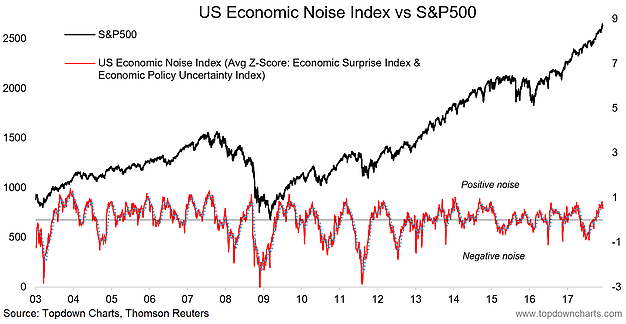This post looks at a curious and obscure indicator on the US economy which has in the past provided some clues on the outlook for the US stock market.I call the indicator the “Economic Noise Index” and it combines the signals from the Citi Economic Surprise Indexes and the Economic Policy Uncertainty Indexes (inverted), using z-scores to standardize the series.The result is an indicator which reflects the amount of noise and whether it is positive noise or negative noise.
For instance, if the economic policy uncertainty index is very high (which would be low on the chart because I invert it to produce a consistent signal) and the economic surprise index has fallen very low, it would reflect an environment where there is heavy noise with a distinct negative hue.Of course, most astute readers would immediately realize that this is basically like a sentiment index, maybe economic sentiment, and hence sharp and loud negative readings are probably contrarian signals that should be bought – and that is precisely the experience we’ve noticed on the chart.
It works better at picking bottoms than tops, but can still be very informative on picking selloffs and turning points.Rather than just going against high readings (which results in a number of false positives… or is that false negatives?), the better course is to look for high levels of positive noise, and then wait for the indicator to rollover or turn down e.g. as in 2008, 2010, 2011.At present the index is at strong positive noise levels, so the next step is to watch for it to rollover – we will be watching this one closely!
The US Economic Noise Index has hit strong positive levels, consistent with the rally in the S&P500, but at this point it is on watch for any signs of rolling over (not yet).

Looking at the components of the indicator, you can see the strength is coming from the economic surprise index, yet policy uncertainty is rising (bad noise), which is understandable and to be fair is probably the most likely source or catalyst of any potential selloff or correction.












Leave A Comment